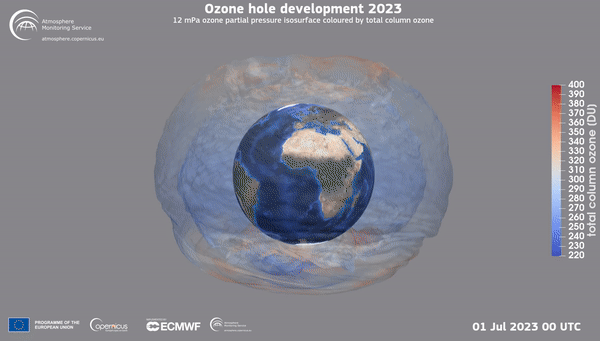The ozone hole above Antarctica opened early this year. Huge Tonga undersea volcano eruption may be to blame
Water injected into the stratosphere by the Hunga Tonga volcanic eruption may be causing ozone destruction.
The ozone hole above Antarctica has opened up unusually early this year. Scientists think the cataclysmic Hunga Tonga volcanic eruption that sent shockwaves around the world in January 2022 may be to blame.
The development is not unexpected. Ozone experts predicted earlier this year that the eruption, which injected 50 million tons (45 million metric tons) of water vapor into Earth's atmosphere, is likely to have an impact on Earth's protective ozone layer in the years following the eruption.
Concentrations of water vapor in the stratosphere, the second lowest layer of Earth's atmosphere where the ozone layer resides, increased by 10% due to the explosion of the undersea volcano. That, according to Paul Newman, the chief scientist for atmospheric science at NASA Goddard Space Flight Center, resulted in "significant cooling" in the stratosphere, which is bad news for ozone levels.
New data released by the European environmental monitoring agency Copernicus now suggest that the predictions were likely correct. Concentrations of ozone above Antarctica dropped extremely low in early July. Such early onset of the ozone layer's destruction has been recorded only about a dozen times in the 43 years since scientific measurements began, Copernicus said in a statement.
Related: Auroras blasted a 250-mile-wide hole in Earth's ozone layer

The data show that the extent of the ozone hole in August 2023 ranks as the 10th largest on record. Currently, the hole is over 6 million square miles (16 million square kilometers) in size. It will continue to grow until about the end of September when Antarctica begins to warm as it moves into its spring period. The hole will take at least until the end of November to close, but it may survive much longer.
The stratospheric cooling that results from increased concentrations of water vapor in the stratosphere leads to more frequent formation of polar stratospheric clouds. Scientists believe that these eerie iridescent clouds that form at altitudes between 9 to 15 miles (15 to 25 kilometers) provide the right chemical environment for ozone depleting substances (ODS) present in the stratosphere to do their destructive work. Although most of these substances, such as chlorofluorocarbons and hydrofluorocarbons previously used in aerosol sprays and refrigerators, were banned by the 1987 Montreal Protocol, their natural breakdown takes decades and their concentrations in the atmosphere are still high.
Get the Space.com Newsletter
Breaking space news, the latest updates on rocket launches, skywatching events and more!
Vincent-Henri Peuch, the director of the Copernicus Atmosphere Monitoring Service (CAMS), said in the statement that although researchers can't tell for sure whether Hunga Tonga is to blame for this year's above-average ozone depletion, they hope to learn more from measurements in the coming months.
"Our ability to provide three-dimensional analyses and forecasts of the ozone in the poles is a powerful approach to monitor in real time how ozone holes develop, and to assess what are the key drivers behind what is being observed," Peuch said. "This gives us insights about the extent to which particular events affect this year’s development of the Antarctic ozone hole, such as the Hunga Tonga-Hunga Ha’apai eruption of last year that increased the amount of water vapor in the stratosphere."
The aftermath of the Hunga Tonga eruption is a completely new territory for scientists as no previous volcanic eruption in documented history has injected so much water into the atmosphere.
Other factors, however, are at play, when it comes to the unusual behavior of the ozone layer, according to Copernicus.
The previous three years saw very large and long-lasting ozone holes, although those holes opened later in the season than they did this year. Scientists think that the progressing climate change may be contributing to ozone depletion despite the gradual decrease in atmospheric concentrations of ozone depleting substances. Processes in the atmosphere are complex, and models suggest that while temperatures near Earth's surface are getting undoubtedly higher, the stratosphere is in fact cooling down (even without the additional water from Hunga Tonga) — and that means more ozone destruction.
"The previous three years have been characterized by strong and persistent Antarctic stratospheric polar vortices and the ozone holes have been among the largest and longest lasting on record," Copernicus said in the statement. "This does not imply that the Montreal Protocol to ban the use of ozone depleting substances is not working. On the contrary, under these conditions, ozone depletion would have been even stronger without the ban."
Join our Space Forums to keep talking space on the latest missions, night sky and more! And if you have a news tip, correction or comment, let us know at: community@space.com.

Tereza is a London-based science and technology journalist, aspiring fiction writer and amateur gymnast. Originally from Prague, the Czech Republic, she spent the first seven years of her career working as a reporter, script-writer and presenter for various TV programmes of the Czech Public Service Television. She later took a career break to pursue further education and added a Master's in Science from the International Space University, France, to her Bachelor's in Journalism and Master's in Cultural Anthropology from Prague's Charles University. She worked as a reporter at the Engineering and Technology magazine, freelanced for a range of publications including Live Science, Space.com, Professional Engineering, Via Satellite and Space News and served as a maternity cover science editor at the European Space Agency.









